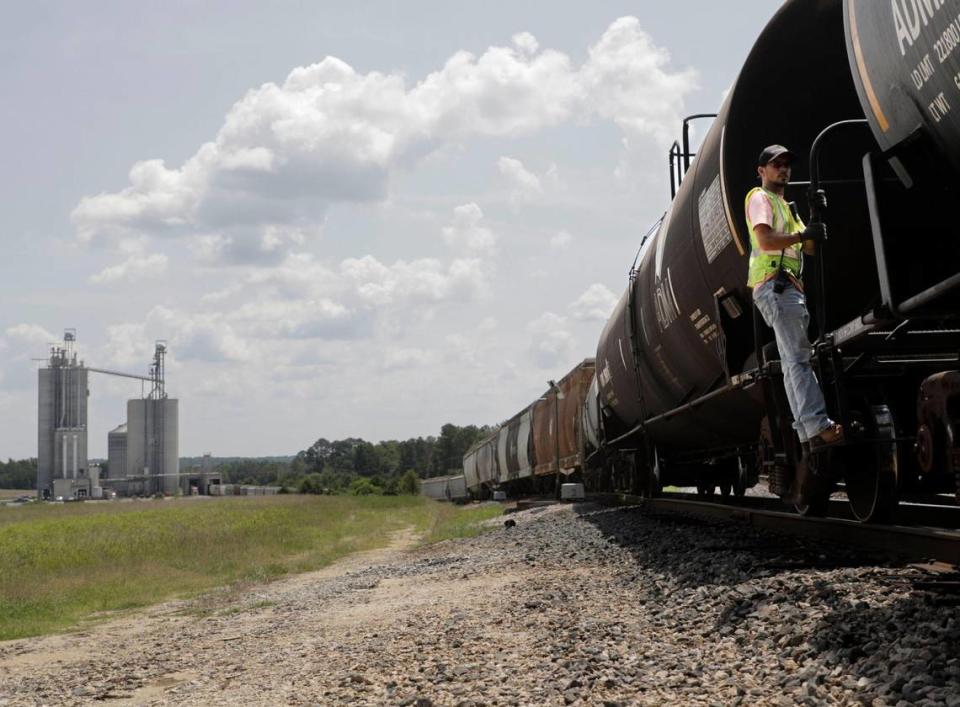New investment flocks to counties near Charlotte. Now, growth is trying to keep up.
In a blur, empty 12-ounce cans of High Noon hard seltzer whip around a conveyor belt. In another instant, each is filled to the brim with a mix of ingredients including grapefruit juice, water and of course, vodka.
A filler operator — one of about 230 E. & J. Gallo Winery employees — keeps close watch. The work happens inside a brightly-lit, cavernous 1.5-million-square-foot facility along a mostly rural stretch of South Carolina road.
Gallo plans on creating nearly 500 jobs here over the next few years at its new East Coast operations in Fort Lawn, Chester County, in South Carolina, about 45 minutes from Charlotte. Once fully staffed, the California-based wine giant’s employee base would be roughly half the size of Fort Lawn itself, a town of under 1,000 people.
When announced two years ago, Gallo’s $423 million investment was part of a larger wave of economic growth that arrived at the doorstep of small, often rural, counties near Charlotte like Chester.
That wave only seems to be picking up momentum coming out of the pandemic, with more people and companies flocking to the South from traditional economic engines like the Northeast.
The new investments helped foster a rebirth for towns that a decade or more ago were experiencing population and job losses, according to about a dozen interviews with area economic development leaders, county officials and real estate experts.
In many cases, these communities have ties to the textile industry but are now seeing new life in the form of manufacturing plants, distribution centers and technology firms.
Many companies in the Rock Hill region got incentives, but have they kept their promises?
With such growth comes an acute focus on how existing infrastructure can keep pace with the changes, leading some counties to figure out ways to cover the multi-million dollar cost of expanding systems like wastewater treatment facilities.
Companies are choosing these counties for cheaper land, tax incentives and easy access to highways and rail lines, experts told The Charlotte Observer. Meanwhile, new housing and commercial investment appear to be following.
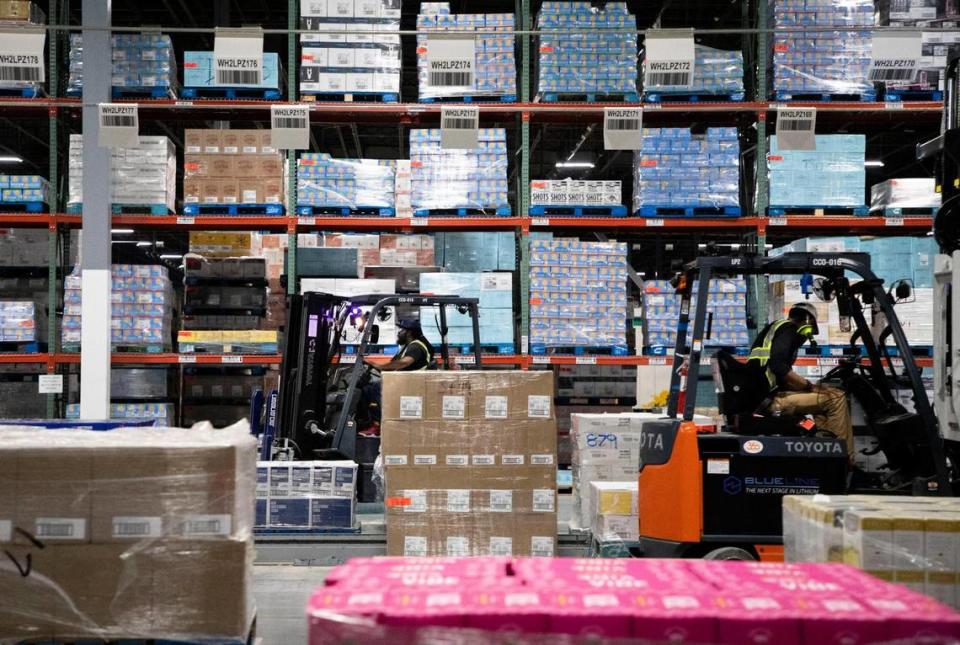
California winery expands to SC
For the first time in a century, Chester County is poised to increase its population. It had stayed pretty much flat at around 33,000 people.
Two national home builders — Lennar and LGI Homes — are building two subdivisions with about 600 homes combined. More housing is planned. And a prominent developer is buying up two shuttered storefronts in downtown Chester with plans to invest millions to bring new retail, including a coffee shop, and some apartments.

Similar stories are playing out north of Charlotte too.
That includes the Catawba County communities of Hickory and Maiden, where nationally-recognized companies like Apple and Microsoft invested hundreds of millions of dollars in data centers. Apartment buildings are springing up along with restaurants and distilleries.
And in late July, Gov. Roy Cooper announced that fiber optic cable giant CommScope was expanding its operations in Catawba County with a $60 million investment. It would bring about 250 jobs.
In other parts of the region, manufacturers have built sprawling campuses, producing everything from tires and trash bags to fiber glass as well as processing lithium hydroxide for electric vehicles.
One of those big campuses belongs to Gallo in tiny Fort Lawn — now home to the world’s largest privately-held winery.
But don’t expect vineyards on the sprawling 640-acre site.
Gallo mostly will be bottling, canning, warehousing and distributing wine and spirits under many of its brands like New Amsterdam Vodka and Barefoot Wine. It also will produce its popular High Noon seltzers — 12 million cases a year, or about 300 million cans, according to company executives.
Robert Long, Chester’s economic development director, didn’t pause when choosing his words to talk about his county’s recent economic successes.
“We’re at the very front end of a renaissance for downtown Chester,” Long said.
There’s also a massive project in the works in York County, S.C. — a potential $1 billion economic development deal for a data center known as Project Cobra, the Rock Hill Herald reported.
The most recent public documents on the project show an anticipated investment of $1 billion and a dozen new jobs. The company would be required to invest $900 million within eight years for the agreed upon tax incentives.
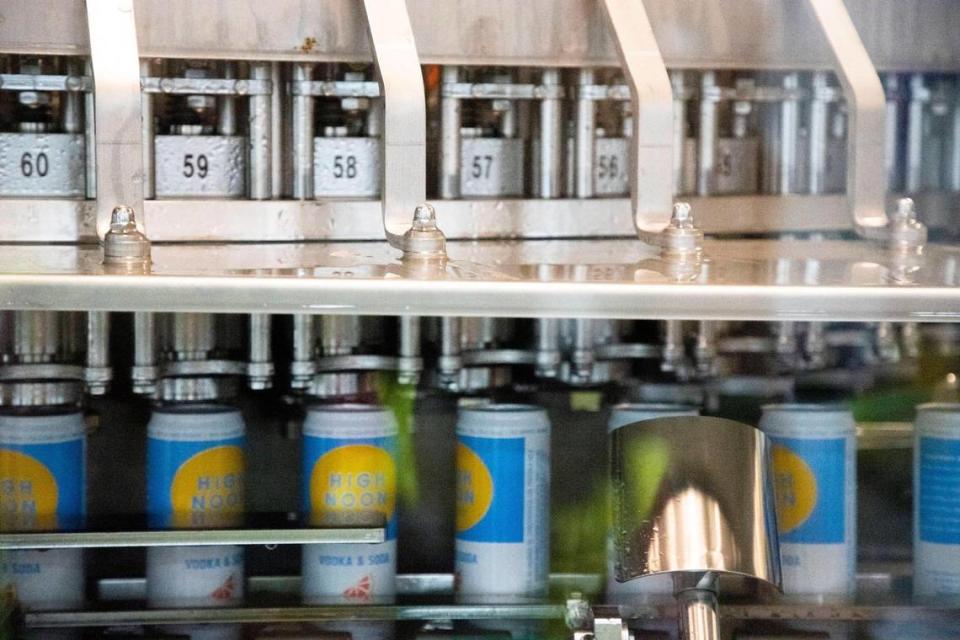
‘Remaking’ North Carolina’s economy
North Carolina also has been no stranger to recent economic successes.
Last year, there were 151 projects announced in the state, resulting in roughly 27,000 jobs and $15.6 billion in new investment, according to the Economic Development Partnership of North Carolina.
That included North Carolina’s first car assembly plant in Chatham County, southwest of Raleigh. VinFast’s initial plans are to make 150,000 electric vehicles a year. The $4-billion project was said to be the largest economic development project in state history.
In the Mecklenburg County region, about $5.8 billion of investment was announced across roughly 160 projects in the past five years, according to data from Cooper’s office.
That includes Eli Lilly and Company’s $1-billion project in Cabarrus County for a pharmaceutical manufacturing plant and a $640-million project from Macy’s to build a massive fulfillment center in Rowan County.
The pace has only accelerated in recent years, economic experts say.
For the first time, the Carolinas are part of six states in the South that contribute more to the national GDP than the Northeast, Bloomberg reported in June. The other states are Florida, Texas, Georgia and Tennessee.
The shift happened during the pandemic, the news site reported. It can be attributed to transplants and corporations flocking south, with attractive cash and tax incentives.
The economic wins for rural towns is also a result of Charlotte’s continued growth, Michael Walden, a Reynolds distinguished professor emeritus of economics at North Carolina State University, told the Observer.

In North Carolina, Walden has watched how the state has grown its economy over the last 50 years from one based on textiles, furniture and tobacco to banking, manufacturing, technology and healthcare.
“North Carolina has done an amazing job of remaking its economy,” Walden said.
Investors looking at North Carolina might quickly find out prices are higher in places like Raleigh and Charlotte than they initially thought, Walden said. That means the phone will start ringing in smaller, more rural towns.
“Some of the metro areas that are one notch or a couple notches down from Raleigh and Charlotte are getting a look they wouldn’t have gotten before,” Walden said.
Helped by widening highways
One place that’s been getting another look is Rowan County.
Retail giant Macy’s is investing $584 million to build an automated fulfillment center in China Grove. The small town is 40 minutes north of Charlotte.
The 1.4-million-square-foot development landed there because there is no more space in counties closer to Charlotte, Rod Crider, president and CEO of the Rowan Economic Development Council, told The Observer. Macy’s plans to employ 2,800 people once fully operational.
Crider credits recent economic development successes to the widening of Interstate 85, completed three years ago. He also praised pro-growth elected officials.
In Rowan, county leaders are trying to get ahead of the growth.
Over the past few years, the county heard of cases where employers had a tough time recruiting candidates because of the lack of available housing, Crider said. “So we have more people moving here, but not enough new houses or residential units being built to accommodate that demand,” he said.
They have started to track housing developments so they can tell employers where new developments are planned and what their price ranges are.
Half a dozen single-family subdivisions are approved or planned, and two multifamily complexes recently have opened, with a third under construction in the county.
Rowan is expecting 20,000 new jobs if all speculative properties are acquired.
“We know that it’s coming,” Crider said. “You can see areas where the growth kind of outstripped the community’s ability to keep up… We want to take a lesson from that.”
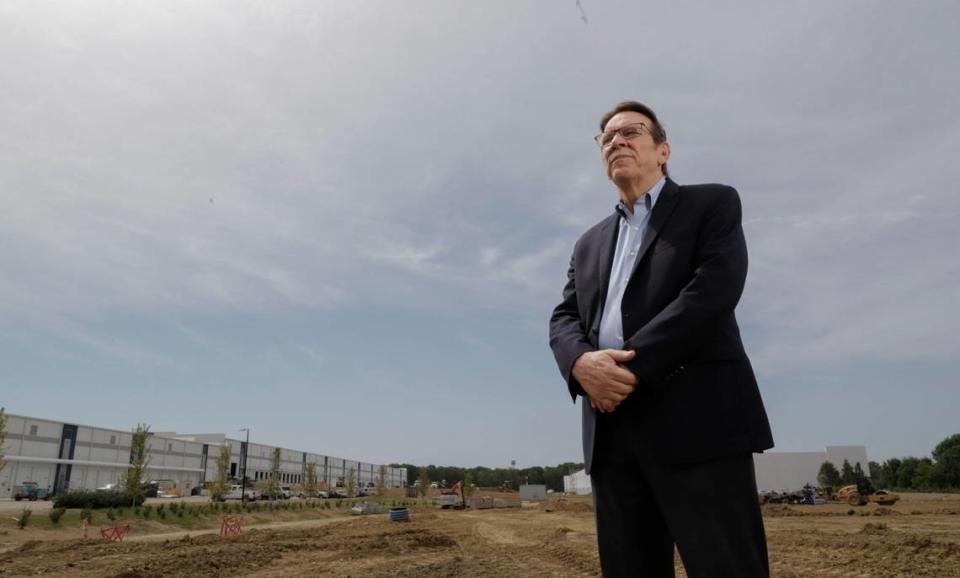
Avoiding the single industry death spiral
Twenty years ago, Cabarrus and Rowan counties were rocked by the largest single-day layoff in state history. The bankruptcy of textile giant Pillowtex Corp., a maker of pillows and sheets based in Kannapolis, led to about 4,800 local workers losing their jobs.
Pillowtex predecessor Cannon Mills opened in 1908 and built most of the town’s infrastructure for its employees.
By the time the town of Kannapolis established itself in 1984, some 30,000 people were employed by the mills. A number of missteps and missed opportunities by the last four Pillowtex CEOs, contributed to the company’s demise in 2003, an Observer analysis found.
“We’ve been fighting our way back from that ever since,” Crider said.
Kannapolis, for instance, welcomed the North Carolina Research Campus to its downtown where the mills once stood. The 350-acre site hosts eight universities and the David H. Murdock Research Institute, as well as companies focused on improving health through nutrition.
A new $52-million minor league baseball stadium and the West Avenue Social District where drinking alcohol is permitted outdoors in public areas, also help attract people to the downtown area.
Other communities across the region are also working to diversify their economy, so they are not yoked to one industry.
To the northwest in Catawba County, local leaders didn’t experience a mass layoff in the textile industry, although that sector was shrinking too. But they were tracking population losses in 2010, especially among people between the age of 20 and 44. The county also was shedding jobs, said Mary Furtado, the Catawba County manager.
“We view that as a death spiral,” Furtado said.
Population and job declines got the county’s collective attention. Local leaders began focusing on ways to create jobs, attract private investment and improve the quality of life.
Hickory, for instance, has been building a 10-mile walking trail to the Catawba River. That has spurred investment, including the redevelopment of a former mill into shops and restaurants.
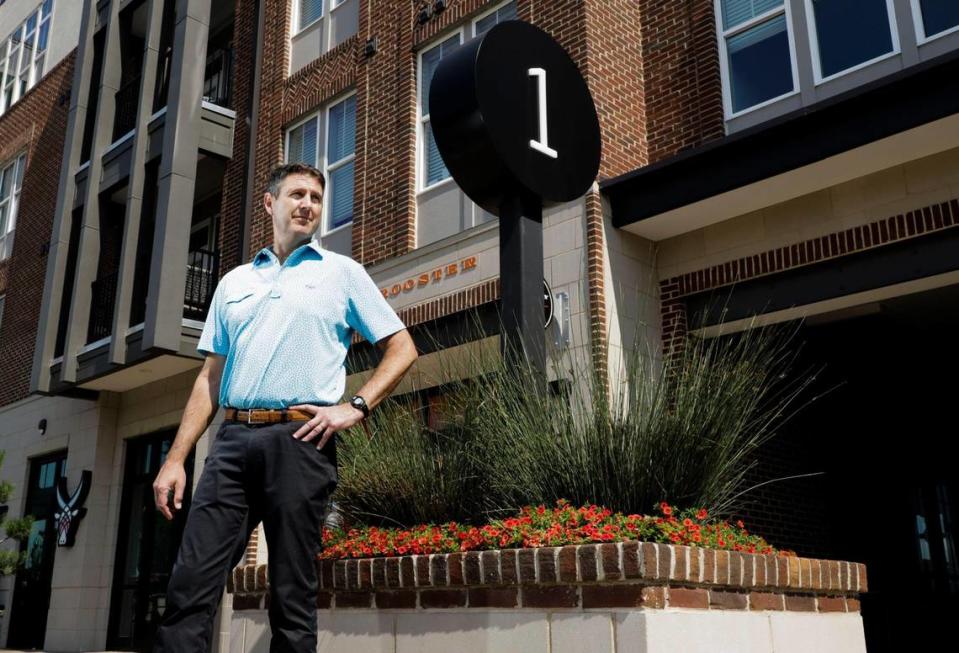
In 2021, a five-story apartment building called One North Center opened up in downtown Hickory. It features a sushi restaurant on the ground floor.
“We didn’t just want to be a bedroom community of Charlotte,” Furtado said. Economic success stories began to increase. Fiber optic cable and communications companies like Corning made multi-million investments along with other firms.
The plan appears to be working. In addition to such investments, Catawba County saw a 4% increase in population over the last decade, up to 160,610 people from 154,358.
Managing the growing pains
But big new industries mean new pressures on existing infrastructure.
When you’re in the shadows of a city like Charlotte, growth is bound to come, said Phillip Thompson-King. He’s executive director of the Chester County Wastewater Recovery (formerly Chester Sewer District).
The district manages three wastewater treatment plants. A fourth is run by the county.

Chester County Wastewater Recovery’s Lando/Manetta plant is on the eastern end of the county, in an area close to much of the county’s industrial and residential growth, Thompson-King said.
The district bought Lando/Manetta in the 1980s. A now-shuttered textile mill built the treatment plant around the 1930s or ‘40s.
It initially was rated to handle 125,000 gallons of wastewater per day. Over the past 15 years, the district increased the capacity to 800,000. The last time the plant was expanded was about five years ago, Thompson-King said, to 1.2 million gallons.
The reason?
Economic development, specifically more industries coming in. In recent years, one of the largest tire companies in the world, Giti Tire — headquartered in Singapore — opened up a facility in Chester County.
Industries use 1,000 gallons of wastewater per developable acre, Thompson-King said. On the residential side, a single-family home uses 250 gallons per day per home.
Given projected growth, the Lando/Manetta plant needs to address its capacity issue again, Thompson-King said. The wastewater recovery district is in negotiations with another provider to shift flows from Lando/Manetta.
Thompson-King declined to provide further details, saying those talks are ongoing.
If that deal falls through, the district would need to expand the facility, a lengthier process given how expensive adding capacity can be, Thompson-King said.
Finding ways to plan for more wastewater demand has been on Thompson-King’s plate since he started the job in 2015. For Thompson-King, it becomes a balance of keeping current service going while preparing for growth.
This balancing act is happening in many other counties in the Charlotte region. How to grow in a manageable way that won’t harm the future.
With more housing coming, there can be more amenities, Thompson-King said, like movie theaters and recreational opportunities.
“The challenge as we mature is having the bandwidth to manage the growth,” he said. “We’re going to have growing pains.”
